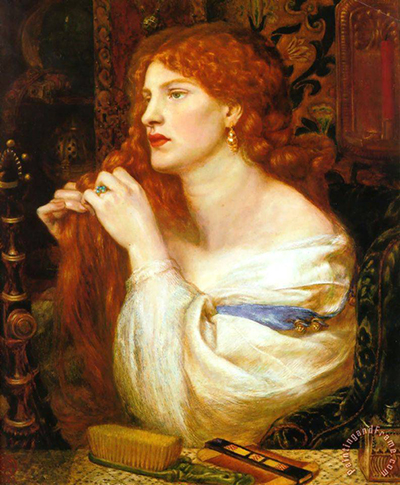The Fazio's Mistress will remain to be the most admired work done by Daniel Gabriel Rossetti. His paintings were very influential as compared to any other medium he was involved under.
Though he rarely did a public exhibition after an over-sensitized reaction from his critics. This picture was done in the year 1863 and was much reworked in 1873; the only thing that was not changed was the title (Fanny Cornforth). It is an important yet very interesting picture. On looking at the picture, you can see a woman, hairbrush, a comb, a perfume container, and a fancy mirror which all symbolize worldliness of a lady’s beauty. The Fazio’s mistress was done by DGR to pay tribute to Italian painter known as Titian.
Significantly, the painting includes or belts out three distinct worlds: the sitter; Fanny Cornforth location of the painting’s modernity, the Tiziano Vecellio painting style, and the "Bricabrac," (as DGR mentioned it) citing to the sixteenth century Venice; the title also refers to Dante's world and thirteenth-century Florence. The frame of 1863 version of the picture was carved with the part of the Provençal Italian music that Fazio degli Uberti had written about his mistress which led to DGR naming the painting as he did.
From these three perspectives, we can define three main points regarding DGR’s work as a painter and why he chose to paint the picture; which is ancient Italian, Venetian, and modern. In this point of view, the description acts as an allegory of flight of the artistic career of DGR. The move DGR made to Venetian and Titian models was a move to explore more ideal forms of embodiment, in which Mary Magdalene’s figure was a Christological form. Fazio’s mistress is a “body's” form of the similar romance state of being. Blake called these female figures “emanations”- which are externalized predictions of a creative desire experience.
Solely, it is typical for DGR that he offered an act of pure symbolization- this highly decorative artwork, this Venetian as a symbol of his creative work. Venetian art was not common, especially in English reading of art history as people believed it was decorative but meaningless. DGR employs the Venetian style in this painting and goes through an effect arguing through actions of art creation. Nevertheless, he is attesting that works of art are portrayed inside it. In contrast, an art which is emblematic and narrative commits itself to be philosophical and quotidian definitions- at their outrageous possibility, to moral meanings.
This painting is similar to his other pictures like woman combing hair and also his native picture of Lady Lilith in which the sitter in both of the arts is still Fanny Cornforth. The artwork is located in the Tate gallery in Great Britain, UK. Daniel Gabriel Rossetti was greatly inspired by Italian painter Tiziano Vecellio whom he also paid homage in his painting Fazio’s mistress.




